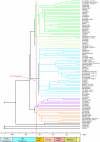Diversification of Neoaves: integration of molecular sequence data and fossils - PubMed (original) (raw)
Diversification of Neoaves: integration of molecular sequence data and fossils
Per G P Ericson et al. Biol Lett. 2006.
Abstract
Patterns of diversification and timing of evolution within Neoaves, which includes almost 95% of all bird species, are virtually unknown. On the other hand, molecular data consistently indicate a Cretaceous origin of many neoavian lineages and the fossil record seems to support an Early Tertiary diversification. Here, we present the first well-resolved molecular phylogeny for Neoaves, together with divergence time estimates calibrated with a large number of stratigraphically and phylogenetically well-documented fossils. Our study defines several well-supported clades within Neoaves. The calibration results suggest that Neoaves, after an initial split from Galloanseres in Mid-Cretaceous, diversified around or soon after the K/T boundary. Our results thus do not contradict palaeontological data and show that there is no solid molecular evidence for an extensive pre-Tertiary radiation of Neoaves.
Figures
Figure 1
Family-level relationships within Neoaves estimated by Bayesian analysis of five nuclear genes (5007 nucleotide positions). Nodes that received a posterior probability value of less than 95% have been collapsed. Note that the branch lengths are not proportional to the number of nucleotide substitutions along each branch. Neoavian families fall into a few reciprocally monophyletic clades (coloured) that roughly correspond to ecological adaptations of extant taxa. Nodal numbers correspond to clades discussed in the text. Letters in boxes, referring to table 3 in the electronic supplementary material, indicate fossil calibration points.
Figure 2
Chronogram (calibrated ultrametric tree with branch lengths proportional to time) for Neoaves estimated using PATHd8. Note that the split between Palaeognathae (represented by Rheidae and Apterygidae) and Neognathae is not shown, but estimated to be 177 Myr ago. We do not consider this age to be reliable due to difficulties in aligning the intron sequences of palaeognaths with those of the other taxa.
Comment in
- Nuclear DNA does not reconcile 'rocks' and 'clocks' in Neoaves: a comment on Ericson et al.
Brown JW, Payne RB, Mindell DP. Brown JW, et al. Biol Lett. 2007 Jun 22;3(3):257-9; discussion 260-1. doi: 10.1098/rsbl.2006.0611. Biol Lett. 2007. PMID: 17389215 Free PMC article. No abstract available.
Similar articles
- Strong mitochondrial DNA support for a Cretaceous origin of modern avian lineages.
Brown JW, Rest JS, García-Moreno J, Sorenson MD, Mindell DP. Brown JW, et al. BMC Biol. 2008 Jan 28;6:6. doi: 10.1186/1741-7007-6-6. BMC Biol. 2008. PMID: 18226223 Free PMC article. - Eocene diversification of crown group rails (Aves: Gruiformes: Rallidae).
García-R JC, Gibb GC, Trewick SA. García-R JC, et al. PLoS One. 2014 Oct 7;9(10):e109635. doi: 10.1371/journal.pone.0109635. eCollection 2014. PLoS One. 2014. PMID: 25291147 Free PMC article. - Genomes, fossils, and the concurrent rise of modern birds and flowering plants in the Late Cretaceous.
Wu S, Rheindt FE, Zhang J, Wang J, Zhang L, Quan C, Li Z, Wang M, Wu F, Qu Y, Edwards SV, Zhou Z, Liu L. Wu S, et al. Proc Natl Acad Sci U S A. 2024 Feb 20;121(8):e2319696121. doi: 10.1073/pnas.2319696121. Epub 2024 Feb 12. Proc Natl Acad Sci U S A. 2024. PMID: 38346181 Free PMC article. - Bird evolution in the Eocene: climate change in Europe and a Danish fossil fauna.
Lindow BE, Dyke GJ. Lindow BE, et al. Biol Rev Camb Philos Soc. 2006 Nov;81(4):483-99. doi: 10.1017/S146479310600707X. Epub 2006 Aug 8. Biol Rev Camb Philos Soc. 2006. PMID: 16893476 Review. - The Origin and Diversification of Birds.
Brusatte SL, O'Connor JK, Jarvis ED. Brusatte SL, et al. Curr Biol. 2015 Oct 5;25(19):R888-98. doi: 10.1016/j.cub.2015.08.003. Curr Biol. 2015. PMID: 26439352 Review.
Cited by
- Insights into avian molecular cytogenetics-with reptilian comparisons.
Griffin DK, Kretschmer R, Srikulnath K, Singchat W, O'Connor RE, Romanov MN. Griffin DK, et al. Mol Cytogenet. 2024 Oct 31;17(1):24. doi: 10.1186/s13039-024-00696-y. Mol Cytogenet. 2024. PMID: 39482771 Free PMC article. Review. - Stem albatrosses wandered far: a new species of Plotornis (Aves, Pan-Diomedeidae) from the earliest Miocene of New Zealand.
Ksepka DT, Tennyson AJD, Richards MD, Fordyce RE. Ksepka DT, et al. J R Soc N Z. 2023 Nov 13;54(5):643-659. doi: 10.1080/03036758.2023.2266390. eCollection 2024. J R Soc N Z. 2023. PMID: 39440284 Free PMC article. - Modeling Substitution Rate Evolution across Lineages and Relaxing the Molecular Clock.
Mello B, Schrago CG. Mello B, et al. Genome Biol Evol. 2024 Sep 3;16(9):evae199. doi: 10.1093/gbe/evae199. Genome Biol Evol. 2024. PMID: 39332907 Free PMC article. Review. - Nest site correlates with nest type and body size in Troglodytidae passerines.
Barros-Leite A, Francisco MR. Barros-Leite A, et al. Biol Lett. 2024 Aug;20(8):20240053. doi: 10.1098/rsbl.2024.0053. Epub 2024 Aug 28. Biol Lett. 2024. PMID: 39191286 Free PMC article. - Reactions of wintering passerines to male calls of the European cuckoo Cuculus canorus.
Tryjanowski P, Golawski A, Jankowiak Ł, Møller AP. Tryjanowski P, et al. Sci Rep. 2024 Jun 20;14(1):14204. doi: 10.1038/s41598-024-64270-7. Sci Rep. 2024. PMID: 38902276 Free PMC article.
References
- Barker F.K, Cibois A, Schikler P, Feinstein J, Cracraft J. Phylogeny and diversification of the largest avian radiation. Proc. Natl Acad. Sci. USA. 2004;101:11 040–11 045. doi:10.1073/pnas.0401892101 - DOI - PMC - PubMed
- Britton, T., Anderson, C.L., Jaquet, D., Lundqvist, S. & Bremer, K. 2006 PATHd8—a new method for estimating divergence times in large phylogenetic trees without a molecular clock. Available at: www.math.su.se/PATHd8 - PubMed
- Cooper A, Penny D. Mass survival of birds across the Cretaceous–Tertiary boundary: molecular evidence. Science. 1997;275:1109–1113. doi:10.1126/science.275.5303.1109 - DOI - PubMed
- Cottam P.A. The pelecaniform characters of the skeleton of the Shoe-bill Stork, Balaeniceps rex. Bull. Br. Mus. Nat. Hist. (Zool.) 1957;5:51–71.
- Cracraft J. Avian evolution, Gondwana biogeography and the Cretaceous–Tertiary mass extinction event. Proc. R. Soc. B. 2001;268:459–469. doi:10.1098/rspb.2000.1368 - DOI - PMC - PubMed
Publication types
MeSH terms
LinkOut - more resources
Full Text Sources

